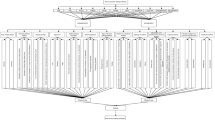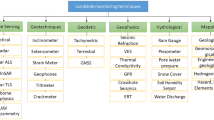Abstract
The Wenchuan earthquake caused numerous landslides and collapses that provide abundant unconsolidated material for future mobilization as debris flows. Debris flows will be very active and cause considerable damage for some time in the affected area. Because of environmental changes related to the earthquake, many potentially dangerous debris flow gullies have yet to be identified. This paper selects the upper Min River from Yinxiu to Wenchuan as the study area, interprets the unconsolidated deposits, and discusses their relationship to distance from the fault. Then, applying that information and the values of other factors relating to debris flow occurrence, the locations of potential debris flows are analyzed by multi-factor comprehensive identification and rapid identification. The multi-factor comprehensive identification employs fuzzy matter-element extension theory. The volume of unconsolidated material in the study area is about 3.28 × 108 m3. According to the analysis by multi-factor comprehensive identification, 47 gullies have a high probability for potential debris flow, 8 gullies have a moderate probability, and 1 gully has a low probability.
Similar content being viewed by others
References
Coussot, P., Meunier, M., 1996. Recognition, classification and mechanical description of debris flows. Earth-Sci. Rev. 40:209–227.
CHEN Ningsheng, HUANG Rong, LI Huan. 2009. Emergency Judge Method and Index of Debris Flow Sites Triggered by 5.1 2 Wenchuan Earthquake. Journal of Mountain Science 27(1):108–114. (In Chinese)
CUI Jing, LIAO Weikun, XU Luoshan. 2009. Application of analysis of fuzzy matter-element based on entropy in evaluation on bidding documents. Chinese Journal of Systems Science 17(4): 61–64. (In Chinese)
Davies, T, Bowman, E. 2008. The recognition and identification of debris flow hazards for proposed development sites in New Zealand. In: CY Chin, Auckland (eds.), Proc. 18th NZGS Geotechnical Symposium on Soil-Structure Interaction. New Zealand. Pp. 1–6.
D. J. Wilford, M. E. Sakals, J. L. Innes, et al. 2004. Recognition of debris flow, debris flood and flood hazard through watershed morphometrics. Landslides 1(1):61–66.
FEI Xiangjun, SHU Anping. 2004. Movement Mechanism and Disaster Control for Debris Flow: Qinghua University Press. Pp.262–267. (In Chinese)
J.S. Levy, J.W. Head, J.L. Dickson, et al. 2009. Identification of gully debris flow deposits in Protonilus Mensae, Mars: Characterization of a water-bearing, energetic gullyforming process. Earth and Planetary Science Letters. In Press.
Jackson LE, Kostaschuk RA, MacDonald GM. 1987. Identification of debris flow hazard on alluvial fans in the Canadian Rocky Mountains. In: Costa JE, Wieczorek GF (eds), Debris flows/avalanches: process, recognition, and mitigation. Rev Eng Geol vol. VII. Pp. 115–124.
Kristensen, S., Starheim, C. 2009. Identification of debris flow potential in steep mountain channels in the Revelstoke area, southern BC. Canadian Association of Geographers (eds), 51st Annual Meeting of the Western Division, British Columbia.
Klubertanz G., Laloui L., Vulliet Laurent. 2009. Identification of mechanisms for landslide type initiation of debris flows. Engineering Geology 109:114–123.
KAN Zhicheng, LI Zhuofen, MA Genai. 2004. Study of debris flow in China: Science Press. Pp. 38–62. (In Chinese)
LV Ruoren. 1986. Factor analysis of debris flow. Mountian Research 3(2):121–128. (In Chinese)
Leonard R. Rubin. 2007. Unbounded sets of maps and compactification in extension theory. Topology and its Applications 155: 82–91.
Roberto A. T. Gomes, Renato F. Guimara. 2008. Identification of the affected areas by mass movement through a physically based model of landslide hazard combined with an empirical model of debris flow. Nat Hazards 45:197–209.
Sharpe, S.C.F. 1960. Landslides and related phenomena: Springer and Praxis Publishing. Pp.21–48.
WANG Nianqin, YAO Yong, LUO Donghai. 2009. Technique for spatial pre-estimation of debris flow. Journal of Lanzhou University(Natural Sciences) 45(1):8–19. (In Chinese)
WU Shuren, SHI jusong, YAO Xin et al. 2008. Analysis and evaluation of geohazard intensity of the Wenchuan earthquake, Sichuan, China. Geological Bulletin of China 27(I1):1900–1906. (In Chinese)
WANG Chen, PAN Feng. 2004. Fuzzy matter-element model for evaluating geotechnical slope stability. Water Resources and Hydropower Engineering 35(9):34–36. (In Chinese)
YOU Yong, LIU Jinfeng. 2009. The Influence on Debris Flow Prevention in the Upriver of Minjiang after Wenchuan Earthquake. Journal of Sichuan University (Engineering Science Edition) 41(supp):16–22. (In Chinese)
Zhang Huiping, Yang Nong, Zhang Yueqiao, et al. 2006. Geomorphology of the Minjiang drainage system (Sichuan, China) and its structural implications. Quaternary Sciences, 26(1):126–135. (In Chinese)
Zhou Rongjun, Pu Xiaohong, He Yulin, et.al. 2000. Recent activity of Minjiang fault zone, uplift of Minshan block and their relationship with seismicity of Sichuan. Seismology and Geology 22(3): 285–294.
Author information
Authors and Affiliations
Corresponding author
Rights and permissions
About this article
Cite this article
Liu, J., You, Y., Chen, X. et al. Identification of potential sites of debris flows in the upper Min River drainage, following environmental changes caused by the Wenchuan earthquake. J. Mt. Sci. 7, 255–263 (2010). https://doi.org/10.1007/s11629-010-2017-z
Received:
Accepted:
Published:
Issue Date:
DOI: https://doi.org/10.1007/s11629-010-2017-z




